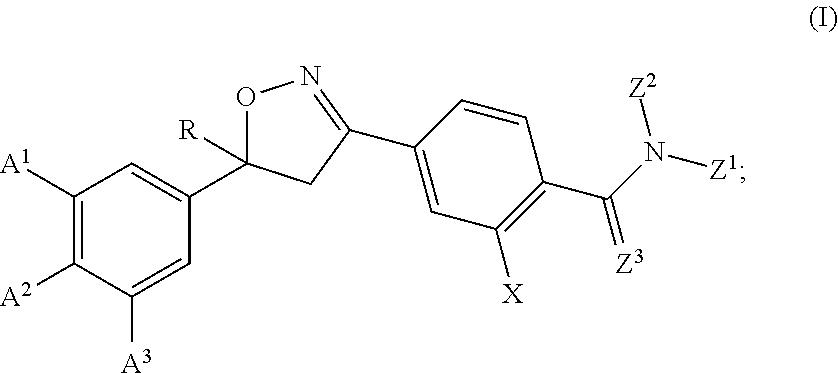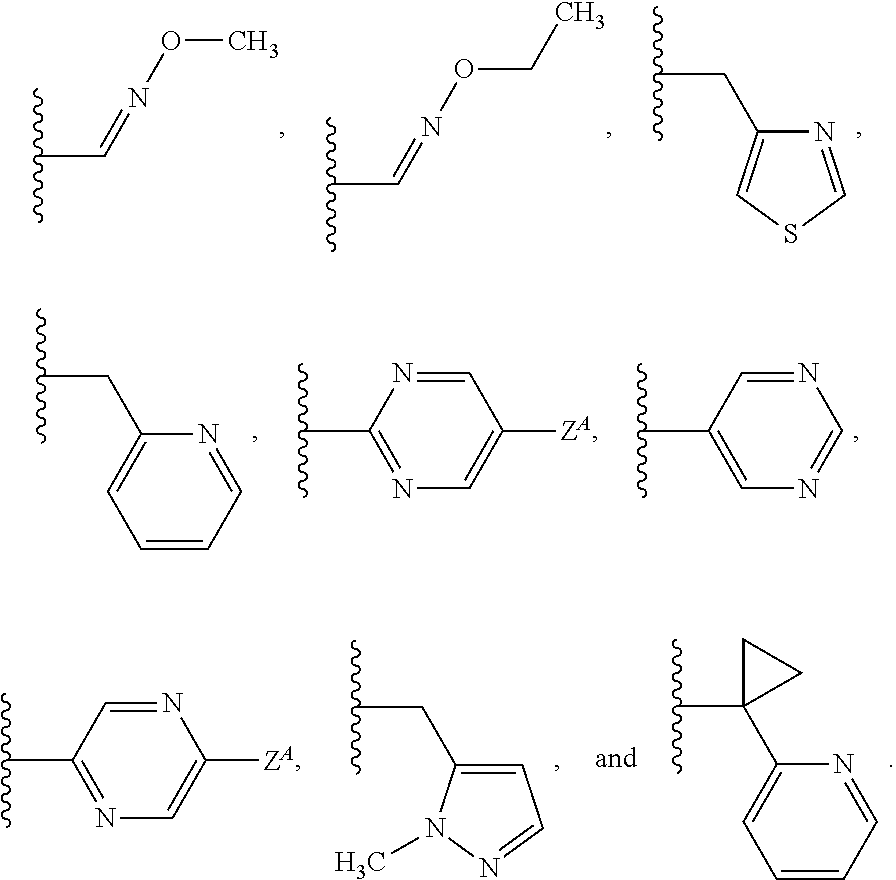Isoxazoline compositions and their use as antiparasitics
a technology of isoxazoline and composition, which is applied in the direction of antiparasitic agents, drug compositions, extracellular fluid disorders, etc., can solve the problems of clinical disease, adverse sub-clinical conditions, and the nuisance of parasites and parasites, and achieves the effects of long duration of activity, convenient use, and convenient us
- Summary
- Abstract
- Description
- Claims
- Application Information
AI Technical Summary
Benefits of technology
Problems solved by technology
Method used
Image
Examples
example 1
Efficacy of Compounds 10-1 and 11-1 Against Cat Fleas (Ctenocephalides felis)
[0297]Adult fleas (20-30) were fed on artificial membranes with blood spiked with Compound 10-1, Compound 11-1, or a positive control (fipronil) at a concentration of 100, 10, or 1 ppm. Flea efficacy was assessed after 48 hr of continuous feeding by comparing the number of killed and damaged fleas with the number of fed fleas. Flea efficacy was 100% for Compound 10-1, Compound 11-1, and fipronil at 100, 10, and 1 ppm.
example 2
Model Animal Studies for Compound 11-1
[0298]The objective of these studies was to assess the efficacy of Compound 11-1 against various parasites. The parasites were:
ArthropodaSpeciesFamilyCommon nameInsectaCtenocephalides felisPulicidaeCat fleaInsectaCimex lectulariusCimicidaeBed bugAcariOrnithodoros moubataArgasidaeChicken tickAcariRhipicephalus sanguineusIxodidaeBrown dog tickAcariMyocoptes musculinusMyocoptidaeRodent fur mite
A. Efficacy Against Fleas on Mice
[0299]Mice were divided into groups of three, and treated topically with 100 ppm body weight, orally with 10 mg / kg bodyweight, or subcutaneously with 10 mg / kg bodyweight of Compound 11-1, fipronil (positive control), or nothing (negative control). These mice were sedated and infested with adult fleas (C. felis) 1, 3, 6, and 24 hr after treatment. Fleas were recovered from the mice after approximately 30 minutes of feeding. The assessment of flea inhibition (% of dead and damaged fleas) was conducted 1 and 24 hr after each infe...
example 3
Efficacy of Various Isoxazolines Against Cat Fleas (Ctenocephalides felis) on Mice
[0315]In this experiment, mice were randomly assigned to a treatment group or a negative control (untreated) group. Each group consisted of three mice. The mice in the treatment groups were orally administered 20 mg / kg bodyweight of various isoxazolines dissolved in 7% DMF-premix and 93% purified water (aqua ad injectabilia). The application volume of these treatments was 0.01 mL / g bodyweight. One hour after treatment, each mouse was sedated and generally infested (whole body) with 30 vital, adult fleas (C. felis). To achieve this, the sedated mice were placed into an infestation-jar, and the fleas were placed directly onto the fur. After approximately 30 minutes of feeding, fleas were recovered from the mice. Assessments for inhibition and mortality were conducted 1 hr, 24 hr, and 48 hr after each infestation. The efficacy was calculated as the percentage of inhibited fleas in the treatment groups rel...
PUM
| Property | Measurement | Unit |
|---|---|---|
| volume | aaaaa | aaaaa |
| concentration | aaaaa | aaaaa |
| particle size | aaaaa | aaaaa |
Abstract
Description
Claims
Application Information
 Login to View More
Login to View More - R&D
- Intellectual Property
- Life Sciences
- Materials
- Tech Scout
- Unparalleled Data Quality
- Higher Quality Content
- 60% Fewer Hallucinations
Browse by: Latest US Patents, China's latest patents, Technical Efficacy Thesaurus, Application Domain, Technology Topic, Popular Technical Reports.
© 2025 PatSnap. All rights reserved.Legal|Privacy policy|Modern Slavery Act Transparency Statement|Sitemap|About US| Contact US: help@patsnap.com



